Backflow in plumbing systems can pose serious risks to your health and safety. To effectively avoid backflow and maintain the integrity of your water supply, regular testing and maintenance of your backflow preventers is essential. Understanding how backflow occurs can help you implement the right preventative measures, ensuring clean water flows in the right direction.
At Pacific Backflow, we emphasize the importance of having certified technicians conduct annual backflow testing. This proactive approach helps identify potential issues before they become serious problems. Regular inspections, along with prompt repairs when necessary, are key steps you can take to safeguard your home or business from contamination.
Proper installation and protection of backflow devices are equally crucial. You can benefit from professional services designed to ensure compliance with local regulations and minimize the risk of backflow incidents. By taking these measures, you not only protect your water supply but also contribute to the well-being of your community.
Understanding Backflow and Its Risks
Backflow in plumbing systems can lead to significant health and safety issues. It is crucial to understand what backflow is, the associated health risks, and how it affects your water supply to maintain clean and safe water for your home or business.
What Is Backflow in Plumbing Systems
Backflow occurs when the normal flow of water in a plumbing system is reversed, allowing contaminated water to enter clean water supplies. This situation typically results from changes in pressure within the plumbing system, often due to construction, heavy water use, or a water main break.
Common scenarios for backflow include cross-connections, such as when a hose connected to a faucet is submerged in contaminated water. Understanding the causes of backflow is essential for effective prevention, preserving the integrity of your plumbing system and water quality.
Health Risks and Water Contamination
The presence of backflow can introduce harmful contaminants into the water supply, leading to serious health risks. Contaminated water may carry bacteria, chemicals, and other hazardous substances that can cause illnesses such as gastrointestinal infections and respiratory issues.
According to health experts, exposure to contaminated water poses severe risks, particularly for vulnerable populations, including children and the elderly. Being aware of the potential dangers associated with backflow can motivate you to take control and implement preventive measures.
How Backflow Affects Your Water Supply
When backflow occurs, the quality of your water supply diminishes, potentially disrupting your daily activities. You might notice discolored water, unusual odors, or sediment, which are signs of contamination.
Additionally, backflow can lead to costly repairs if not addressed. A malfunctioning backflow preventer can cause extensive damage to your plumbing system over time, leading to expensive replacements. Regular backflow testing and maintenance, like those offered by Pacific Backflow, can help ensure your system is working correctly and protect your water supply from contamination.
Common Causes of Backflow
Backflow can occur due to several specific factors in plumbing systems. Understanding these causes is crucial for maintaining a safe water supply in your home or business. Below are key issues that lead to backflow incidents.
Water Pressure Changes
Fluctuations in water pressure can create conditions favorable for backflow. When water pressure drops suddenly, it can cause a reverse flow in your plumbing system. This often occurs during peak usage times or when water mains break.
If the pressure in your home plumbing system is less than that of an external source, contaminants can infiltrate your clean water supply. Installing pressure regulators can help maintain consistent pressure. Regular testing of your pressure system is essential to avoid these risks.
Cross-Connections in Plumbing
Cross-connections are direct links between a potable water supply and a non-potable source. Such connections pose a significant risk for backflow, especially if a sudden drop in pressure occurs.
Common examples include attachments for hoses, irrigation systems, or even appliances like dishwashers. To mitigate this risk, ensure that proper backflow preventers are installed at any cross-connection points. Conduct regular inspections to identify and rectify potential cross-connections in your plumbing.
Plumbing Issues That Trigger Backflow
Various plumbing issues can also incite backflow situations. Problems such as blockages, faulty valves, or deteriorating piping can interrupt the normal flow of water. These issues may cause backflow due to cracks in pipes or misaligned systems.
Regular maintenance and timely repairs can significantly reduce these risks. Hire professionals to conduct evaluations of your plumbing infrastructure. This can prevent small issues from escalating into significant backflow problems. Pacific Backflow offers expert testing and installation services to ensure your plumbing stays compliant and safe.
Essential Methods to Prevent Backflow
Preventing backflow is crucial for maintaining water quality and safety in your plumbing system. The following methods focus on various devices and techniques to ensure your water supply remains uncontaminated and compliant with local regulations.
Installing Backflow Prevention Devices
Backflow prevention devices are critical for stopping contaminated water from entering your clean water supply. Common options include check valves and double-check valves. These devices work by allowing water to flow in only one direction, ensuring that any backflow is blocked.
Regular installation and maintenance of these devices help reduce health risks. If you're unsure which device is best for your plumbing needs, consult a professional. At Pacific Backflow, we specialize in installing and maintaining these essential devices to protect your water quality.
Utilizing Check Valves and Double-Check Valves
Check valves and double-check valves are vital components in backflow prevention. Check valves automatically close when water attempts to flow in the wrong direction, acting as a barrier against contamination. On the other hand, double-check valves provide extra protection by incorporating two valves in one unit.
Install these valves at critical points in your plumbing system, especially where water sources could potentially backflow. Regular inspection and maintenance of these valves are recommended to ensure they function properly. This proactive approach minimizes the risk of backflow events.
The Role of Air Gaps in Plumbing
An air gap is a simple yet effective way to prevent backflow in your plumbing. It is the physical space between the water supply outlet and the flood level of a fixture, such as a sink or bathtub. This gap prevents water from siphoning back into the clean water supply whenever the water level rises.
Ensure that fixtures are installed with adequate air gaps, especially in areas where contamination is a concern. Check local codes for specific requirements surrounding air gaps, as these regulations can vary by jurisdiction. Incorporating air gaps as a preventative measure adds an extra layer of safety to your plumbing system.
Implementing Barometric Loops
Barometric loops are another effective backflow prevention method, particularly in systems with fluctuating pressure. These loops consist of vertical and horizontal piping that creates a U-shaped bend. When pressure changes occur, the water will not flow back into the supply due to the elevation difference.
Properly sized and installed barometric loops can effectively manage backflow risks in your plumbing system. Ensure that these loops are regularly checked and maintained for optimal performance. Consulting with a specialized service like Pacific Backflow can provide insights on the best practices for implementing barometric loops in your plumbing infrastructure.
Maintaining and Inspecting Plumbing Systems
Proper maintenance and inspection of plumbing systems are crucial for preventing backflow issues. Regular checks can help identify potential problems early and save you from costly repairs. Here are important practices to keep your plumbing in top shape.
Regular Plumbing Inspections
Routine inspections are essential for maintaining the integrity of your plumbing system. Schedule inspections at least once a year to assess your entire plumbing layout, including pipes, fixtures, and backflow prevention devices.
During these inspections, look for signs of wear, leaks, or corrosion. A certified technician can systematically check all plumbing fixtures to ensure they function correctly. Don't hesitate to reach out to Pacific Backflow for expert assistance in inspecting your system and preventing backflow concerns.
Testing Backflow Prevention Devices
Backflow prevention devices are vital for keeping your water supply safe. Annual testing of these devices ensures they operate effectively and comply with local regulations.
Qualified technicians will conduct thorough checks, identifying any malfunctions that may compromise the system. If repairs are needed, they will provide detailed proposals outlining the necessary actions. Rely on Pacific Backflow for fast and reliable backflow testing—keeping your property compliant and safe from contamination.
Addressing Plumbing Fixture Concerns
Pay close attention to your plumbing fixtures, as even minor issues can lead to significant backflow problems. Regularly inspect faucets, toilets, and hoses for leaks or damage.
Ensure fittings and connections are secure to prevent water loss and maintain proper pressure. If a fixture appears worn or damaged, addressing it promptly can prevent complications down the line. Implementing preventive measures like regular maintenance and inspections keeps your plumbing system functioning efficiently and protects your water supply.
Best Practices and Professional Help
Implementing best practices in plumbing is essential to prevent backflow and ensure a clean water supply. Professional assistance can further enhance these efforts by providing expertise and reliable services. Below are crucial strategies for maintaining a safe plumbing system.
Choosing Certified Plumbers
Selecting certified plumbers is vital for effective backflow prevention. Look for professionals who have the necessary licenses and training specific to backflow and plumbing systems. Certified plumbers are knowledgeable about local regulations and can ensure compliance during installation and maintenance.
When choosing a plumber, ask about their experience with backflow prevention services. A skilled plumber will inspect your system comprehensively and recommend the best solutions tailored to your needs. This expertise is essential for safeguarding your clean water supply.
Responding to Signs of Backflow
Be vigilant for any signs of backflow in your plumbing system. Common indicators include discolored water, unexpected pressure changes, or foul odors. Addressing these signs promptly can prevent more severe issues.
If you notice these signs, contact a professional immediately. They will conduct thorough inspections and use advanced tools to diagnose the problem. Timely intervention is crucial to maintaining the integrity of your water supply and ensuring your plumbing system functions effectively.
Regular Maintenance for Clean Water Supply
Regular maintenance is essential for ensuring a clean water supply. Schedule annual backflow testing to verify that your preventers are functioning properly and comply with regulations. Testing helps identify potential issues before they escalate into costly repairs.
Consider a proactive maintenance plan, which may include seasonal inspections and cleaning. This ensures your plumbing system remains free from contaminants and operates at peak efficiency. Companies like Pacific Backflow specialize in these services, offering a reliable solution to protect your water supply from backflow risks.
Frequently Asked Questions
Understanding how to effectively prevent backflow in your plumbing system is essential. Here you will find answers to common queries regarding backflow prevention solutions, types of devices, and the necessary steps to protect your home’s water supply.
How can I prevent backflow in my home plumbing system?
To prevent backflow, install a backflow prevention device on your system. Regular maintenance and annual testing are crucial to ensure that your device operates correctly. It’s also important to monitor your plumbing for any changes in water pressure.
What types of backflow preventers are suitable for residential use?
Residential properties typically use atmospheric vacuum breakers, double check valves, or pressure vacuum breakers. Each device serves to prevent backflow in different scenarios, such as irrigation systems or plumbing fixtures. Choose a device that fits the specific requirements of your home.
Which device is essential for preventing backflow in a sprinkler system?
Pressure vacuum breakers are ideal for sprinkler systems. They effectively prevent backflow due to fluctuations in water pressure. Ensure that this device is installed above ground and maintained regularly to function properly.
How can I verify the presence of a backflow prevention device in my system?
Check your plumbing system for visible backflow prevention devices, usually located at the main water supply entry point. You can also review your building’s plumbing plans or contact a plumbing professional for an inspection.
What steps should be taken to ensure backflow does not contaminate drinking water supplies?
Regular testing and maintenance of your backflow prevention devices is vital. Additionally, ensure all hoses and attachments are properly secured, and avoid submerging hoses in contaminated water sources. These practices will help maintain the integrity of your potable water supply.
What are the most reliable backflow prevention methods available for plumbing systems?
The most reliable methods involve using certified backflow preventers tailored to your specific plumbing system needs. Annual testing by a licensed professional, such as those at Pacific Backflow, ensures compliance and functionality. Regular inspections can catch potential issues before they compromise your water quality.











